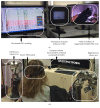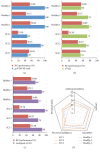Towards Rehabilitation Robotics: Off-the-Shelf BCI Control of Anthropomorphic Robotic Arms
- PMID: 28948168
- PMCID: PMC5602625
- DOI: 10.1155/2017/5708937
Towards Rehabilitation Robotics: Off-the-Shelf BCI Control of Anthropomorphic Robotic Arms
Abstract
Advances in neural interfaces have demonstrated remarkable results in the direction of replacing and restoring lost sensorimotor function in human patients. Noninvasive brain-computer interfaces (BCIs) are popular due to considerable advantages including simplicity, safety, and low cost, while recent advances aim at improving past technological and neurophysiological limitations. Taking into account the neurophysiological alterations of disabled individuals, investigating brain connectivity features for implementation of BCI control holds special importance. Off-the-shelf BCI systems are based on fast, reproducible detection of mental activity and can be implemented in neurorobotic applications. Moreover, social Human-Robot Interaction (HRI) is increasingly important in rehabilitation robotics development. In this paper, we present our progress and goals towards developing off-the-shelf BCI-controlled anthropomorphic robotic arms for assistive technologies and rehabilitation applications. We account for robotics development, BCI implementation, and qualitative assessment of HRI characteristics of the system. Furthermore, we present two illustrative experimental applications of the BCI-controlled arms, a study of motor imagery modalities on healthy individuals' BCI performance, and a pilot investigation on spinal cord injured patients' BCI control and brain connectivity. We discuss strengths and limitations of our design and propose further steps on development and neurophysiological study, including implementation of connectivity features as BCI modality.
Figures










References
MeSH terms
LinkOut - more resources
Full Text Sources
Other Literature Sources
Medical
Molecular Biology Databases
Miscellaneous

